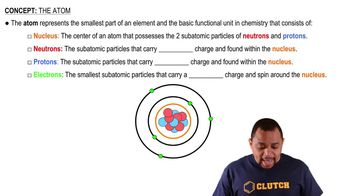How many protons, neutrons, and electrons are in the following atoms? (a) 84Kr (b) 200Hg (c) 70Ga
Each of the following isotopes is used in medicine. Indicate the number of protons and neutrons in each isotope: (a) samarium-153 (b) lutetium-177 (c) bismuth-213 (d) molybdenum-99 (e) lead-212 (f) caesium-131.
 Verified step by step guidance
Verified step by step guidanceKey Concepts
Isotopes

Atomic Structure

Nuclear Medicine

How many protons, neutrons, and electrons are in the following atoms? (d) 80Br
How many protons, neutrons, and electrons are in the following atoms? (e) 184W (f) 181Ta.
Fill in the gaps in the following table, assuming each column represents a neutral atom.
Symbol 79Br
Protons 25 82
Neutrons 30 64
Electrons 48 86
Mass no. 222 207
Complete the first row of the table excluding the isotope symbol.
Complete the second row of the table excluding the row with isotope symbol.
Fill in the gaps in the following table, assuming each column represents a neutral atom.
Symbol 79Br
Protons 25 82
Neutrons 30 64
Electrons 48 86
Mass no. 222 207
Complete the third row of the table.
Fill in the gaps in the following table, assuming each column represents a neutral atom.
Symbol 79Br
Protons 25 82
Neutrons 30 64
Electrons 48 86
Mass no. 222 207
Complete the fourth row of the table.
